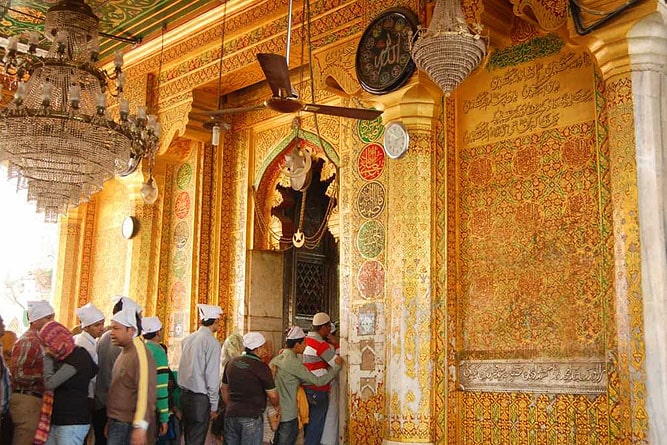Ajmer Sharif Dargah
Muslim pilgrimage site in Ajmer
could-see attraction
Opening hours: 4:00am-9:00pm
Address: Dargah Sharif, Khadim Mohalla, Diggi Bazaar, Ajmer, Rajasthan
Ticket price: Free
Visit duration: People typically spend 30 minutes to 1 hour here
Website: www.dargahajmer.com
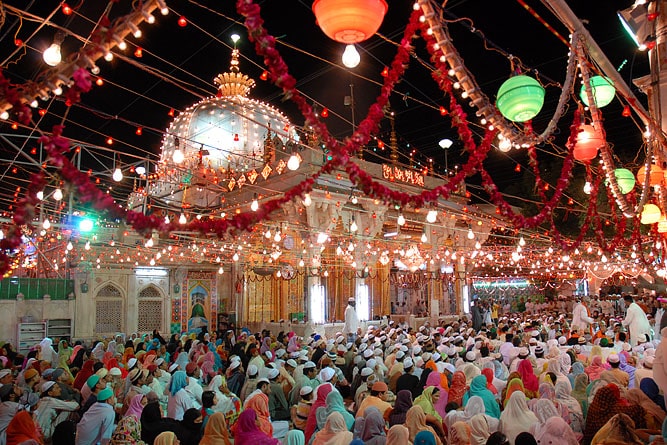
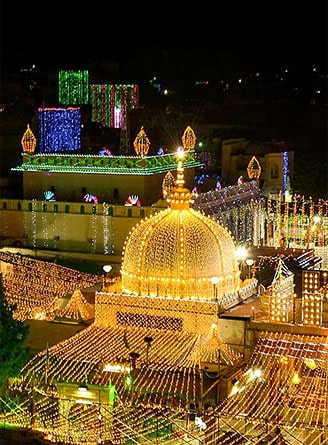
About Ajmer Sharif Dargah
Ajmer Sharif Dargah is the tomb (or Dargah) of the Sufi saint Moinuddin Chishti. The shrine is located at the foot of the Taragarh hill in the city of Ajmer.
You can witness the essence of brotherhood and humanity at the Dargah as it is the most visited pilgrimage not only by Sunni Muslims but also by Hindus and Sikhs since medieval times.
History of Ajmer Sharif Dargah
Moinuddin Chishti was a 13th-century Sufi saint and philosopher. Born in Iran, he arrived in Delhi during the reign of the second Sultanate ruler, Iltutmish. Soon Moinuddin Chishti moved to Ajmer and acquired the reputation of being a compassionate spiritual preacher. He was acknowledged as a great saint after his death. The Dargah became a sacred site after his death in March 1236.
Sultan Iltutmish visited the tomb in 1332 to celebrate the Sufi saint. Mughal Emperor Akbar visited the shrine almost fourteen times and once with his Hindu wife, Mariam-uz-Zamani barefoot to pray for a successor to the throne. Akbar also reconstructed the inner sanctum of the tomb in 1579. Renovations were also made by Jahangir, Shah Jahan, and Jahanara. The Maharaja of Baroda constructed a grand mantle over the dargah in 1800. The Sultanates of India visited the shrine during their reigns.
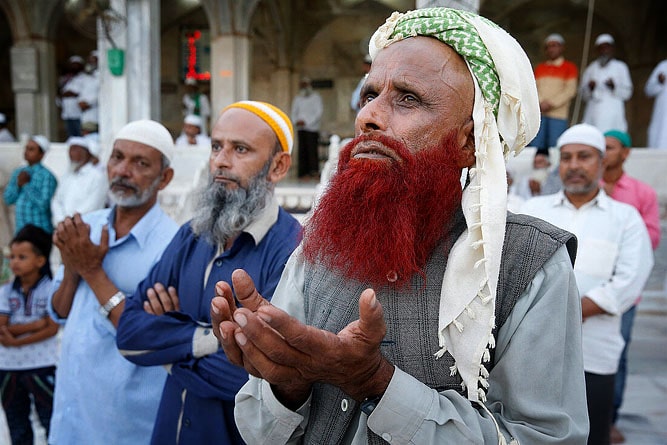
Architecture of Ajmer Sharif Dargah
Ajmer Sharif Dargah is built with marble, sandstone and brick. The complex has nine graves, including Chishti’s. The graves belong to his daughter Bibi Hafiza Jamal and Nizam Sikka and other family members.
The complex has eight gateways and multiple edifices. The Madar Gate and the Delhi Gate are among the other gateways.
In 1911, the 7th Nizam of Hyderabad Mir Osman Ali Khan donated the Nizam Gate. It is the main gate which is a yellow structure with floral patterns. The Naqqar Khana is settled near the gateway. It was a drum house which played music to welcome visitors.
Nizam Gate leads to the Shahjahani Gate. Emperor Shah Jahan had donated the gate and hence it is in his name. The gateway marks the expansion of the Dargah. Through this, you will reach the Buland Darwaza built by Sultan Mahmud Khalji which will lead you to the courtyard of the Dargah. Beyond the three gates you will find the cauldrons, then the dining area and the water tank.
In 1568, Akbar donated a cauldron, the biggest in the world, to the Dargah to keep his promise after winning the battle of Chittorgarh. The cauldron is 20 feet deep and made of an alloy of seven metals. It was brought from Colombo, Sri Lanka. It was carried by elephants in three separate parts and was reassembled in the Dargah. It is a mystery why the rim of the cauldron never gets hot even while food is being cooked. The first meal was enjoyed by Akbar and other fakirs near the Dargah. Jahangir donated the smaller cauldrons as a family tradition.
Aurangzeb constructed the Sandali Masjid which also has a Langar Khana, a dining area and a Mahfil Khana, a community hall. Walking ahead you come across water tanks.
The Jhalara is a natural water tank used by pilgrims to wash their faces, hands and feet before entering the dargah. Similar tanks were added by Shah Jahan and Queen Mary of Teck.
The Begumi Dalaan on the left facet of the dargah and a small platform, Begumi Chabutra, was built by Jahanara Begum. Two doors lead to the sanctum of the dargah. Emperor Jahangir commissioned silver and mother-of-pearl which renovated the ceiling. The ceiling and the walls are engraved with gold.
The Mehfil Khana or royal darbar was constructed in 1888. The darbar is squarely complemented with arabesque and geometric patterns on the ceiling and arcade column.
The white marble dome of the Dargah dates back to 1532 as per the golden letter inscription on the Northern wall. The Nawab of Rampur Haider Ali Khan donated a crown and lotus of gold which is featured on the dome. The Ihaata Noorani of the complex locates the dome. It exhibits Indo-Islamic architecture.
The Jannati Darwaza is built of silver which is also referred to as the Bihisti Darwaza. A large chandelier, Sahn Chirag, was added by Akbar. Another large silver chandelier was donated by the Golden Temple. The Ahaat-e-Noor is a big courtyard where they sing qawwalis and hold religious events.
The Akbari Mosque, now utilized as a religious school, is made of red sandstone. Shah Jahan had added another grand mosque in 1637 which is known as the Jami Masjid. It is settled to the west of the dargah which is built of white marble stone and has a grand marble courtyard that is located on the eastern side.
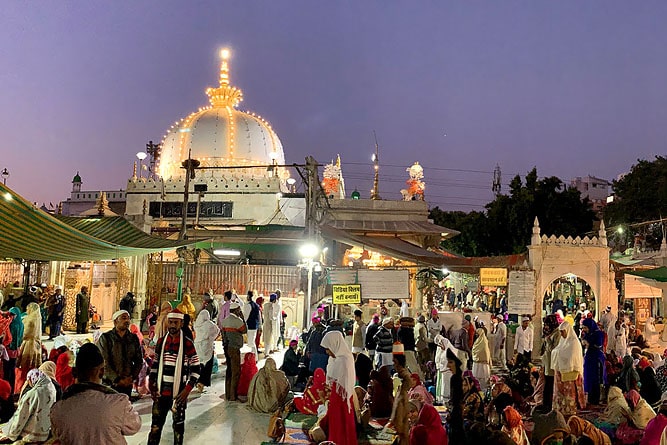
Entry fee and timings
Ajmer Sharif Dargah is open every day from 4:00 am to 11:00 pm. However, visitors are allowed to stay in the Dargah till 9:00 pm in winter and 10:00 pm in summer. There is no charge required to enter the Dargah.
Outside the main entrance, bags have to be left in the cloakroom for ₹10 each.
Facts and tips about Ajmer Sharif Dargah
- The Indo-Islam culture began from this Dargah like the Indo-Saracenic architecture and the Tansen music. The Dargah sources the incense, ittar and sandalwood paste from a Brahmin family since the time of Chishti. Salim Chishti, Abul Faizi and Abul Fazl practiced tolerance at this Dargah. The complex also has one sanctum revered by the Sikhs.
- The Dargah opens with the pre-dawn namaz and holds all five mandatory prayers for the Muslims. At sunset, the Khadims, always present in service or care, carry a candle during the Dua-e-Roshni ritual. Qawwalis are sung after the prayers and at the end, the visitors are asked to leave. Three Khadims stay back and clean the durbar with a peacock broom. The last Khadim recites Karka, a musical verse formed from Sanskrit, Brij and Persian, as he closes the Dargah.
- The Dargah distributes tabarrukh after the morning prayers to the public. The Tabarruk is a blessing offered in the form of a mixture of rice, saffron, nuts, ghee, sugar and dry fruits. The food is cooked at night.
How to reach Ajmer Sharif Dargah
Ajmer Sharif Dargah is located in Ajmer city centre, just 5 minutes walk from Adhai Din Ka Jhonpra Mosque.
See location on Google Maps
Other attractions near Ajmer Sharif Dargah
- Adhai Din Ka Jhonpra Mosque - 450m
- Pushkar - 14 km
FAQs about Ajmer Sharif Dargah
1. Are women allowed inside the Dargah?
Yes, unlike other places women are allowed inside the Dargah. Women are also allowed to participate in the mehfil-i-sama in the Mehfil Khana of the Dargah.
2. Are there any places to stay near the Ajmer Sharif Dargah during the festival time?
The Kayad locality offers shelter to the pilgrims arriving at the Dargah during the festival times, especially during the Urs festival.
3. Is photography allowed in the Dargah?
Yes, you can click photographs on the premises however, photography inside the sanctum is not allowed at the Dargah.
4. Is there any dress code to follow while visiting Ajmer Sharif Dargah?
Yes, the attire must be in tune with the religious ambience. Visitors can wear loose-fitting clothes. However, a headdress is important, so men can wear a handkerchief while women can wear a dupatta.
